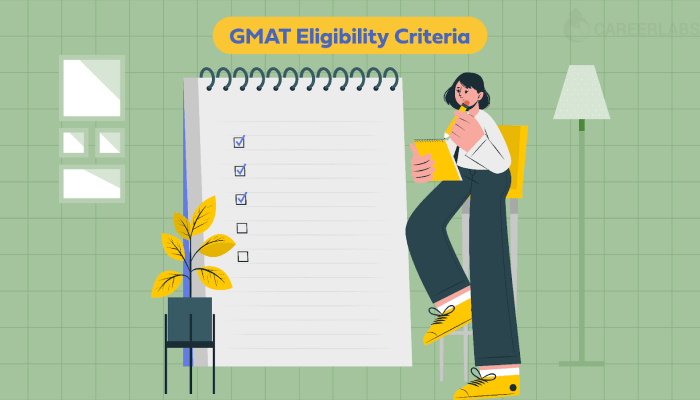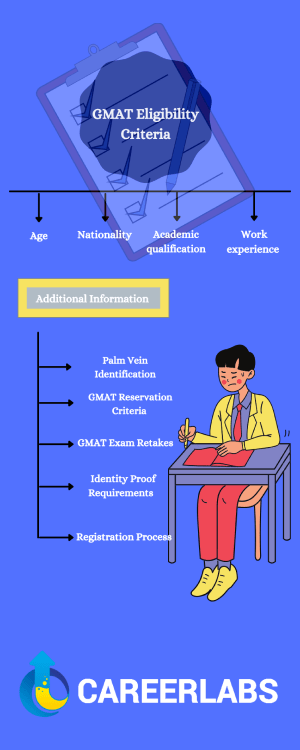
The Graduate Management Admission Test or the GMAT is conducted by the Graduate Management Admission Council (GMAC). If you want to pursue an MBA, in India or abroad, you have to take the exam. This is because the scores you obtain are essential for admissions into top business schools of your choice. According to the official GMAT website, over 200,000+ students take the GMAT all around the world each year. And, over 2500 universities consider the GMAT scores as a criterion for admissions.
The GMAT measures your critical thinking, analytical writing, and logical reasoning skills through four sections— Verbal Reasoning, Quantitative Reasoning, Integrated Reasoning, and Analytical Writing Assessment. We will give you an overview of each section first and then proceed to tell you the eligibility criteria for the GMAT and who can give GMAT exam.
GMAT Sections
Let us have a closer look at what each section entails.
Verbal Reasoning
The Verbal Reasoning section tests your ability to comprehend information, identify errors, to evaluate and critically analyse arguments. It consists of 36 questions that you have to complete within 65 minutes. There are three question types within this section— reading comprehension, sentence completion, and critical reasoning. The Verbal Reasoning score ranges between 6 to 51, which increases by a one-point increment. You need to have a strong command of the English language to ace this section.
Quantitative Reasoning
The Quantitative Reasoning section tests your ability to solve mathematical problems and interpret graphs. It consists of 31 questions that have to be completed in 62 minutes. There are two kinds of questions— data sufficiency and problem-solving in this section. The Quantitative Reasoning’s score, similar to verbal reasoning, also ranges between 6 to 51, which increases by a one-point increment. You need to possess basic knowledge of algebra, arithmetic, and geometry to do well in this section.
Integrated Reasoning
The Integrated Reasoning section tests your ability to identify and evaluate different kinds of data. It consists of various data forms and the questions are based on the data given to you. The data forms given to you include pie charts, graphs, graphical images, tables, bar graphs, etc. It consists of 12 questions which you are to complete within 30 minutes. The question types in this section are— table analysis, two-part analysis, multi-source reasoning, and graphic interpretation. The Integrated Reasoning score ranges between 1 to 8, which increases by a one-point increment.
Analytical Writing Assessment
The Analytical Writing Assessment tests your ability to efficiently analyse an argument. It consists of an argument that you are to analyse by drafting an essay. This argument is to be evaluated and critiqued by you. When critiquing the argument, you need to provide evidence to support your argument. You will have to use your critical thinking and analytical writing skills to construct a logically sound, coherent essay in 30 minutes. The Analytical Writing Assessment is scored between 0 to 6, which increases by a half-point increment.
GMAT Score
The aggregate score of both the verbal and quantitative sections makes up for the total GMAT score. The total GMAT score ranges between 200 to 800, which increases by a ten-point increment. An excellent GMAT score is anywhere between 700 to 750 and a good GMAT score lies anywhere between 550 to 700.
Now that you have a basic idea of the GMAT sections and the GMAT score, let’s take a look at the GMAT eligibility criteria 2023.

GMAT Eligibility Criteria 2023
While the GMAC does not list specific GMAT eligibility criteria for taking the exam, there are a few pertinent factors to keep in mind before applying for the examination. We have listed all the relevant factors below:
Age
Wondering about GMAT age limit? Age will not hinder your goals, You can take the GMAT if you are 13 years of age or above. However, if you are between the age of 13 to 17 years, you can take the GMAT provided you have authorisation or consent from either your parents or a legal guardian. If you are 18 years and above, you don’t need any consent. Besides, the GMAC states no upper limit on age as part of the criteria for GMAT, which means you can attempt the exam at 50 or even 80 if you wish to!
Nationality
Nationality as a factor is also not a factor that hinders the eligibility for GMAT exam. The GMAT has no limitations set down with regards to your nationality, you can appear for the GMAT regardless of the country you come from. However, you need to carry proof of your nationality at the time of the exam. This means that you have to produce valid, government authorised identification proof. It is important to note that these ID requirements vary from country to country. Hence, it is essential for you to go through the ID requirements based on your location before you apply for the exam.
Academic Qualification
The GMAC hasn’t laid down any restriction with regard to your academic qualifications. Having said that, since the GMAT is a graduate exam, it is advisable to have completed an undergraduate degree. While the GMAC might not have specified any qualification requirements as part of eligibility for GMAT, the universities or colleges you plan on applying to might have set guidelines for the same. Hence, it is important to make a note of the university’s eligibility criteria before you start your application process.
Academic Performance
Your academic performance isn’t taken into account when you want to appear for the GMAT. However, business schools and universities value consistent or excellent academic performance over poor, inconsistent academic performance. With exceptional grades, your chances of getting into business school are higher. Additionally, your chance of securing a scholarship also increases with better grades.
GMAT Exam Retakes
If you feel like you haven’t fared well in the GMAT, on your first attempt, you can take the exam again. You can take the GMAT five times within a year. However, do note that there should be a minimum gap of sixteen days between your retakes. In case you achieve that perfect test score of 800, you are not eligible to take the exam for five years. However, it is important to note that the GMAT is an expensive affair and hence, it is advisable for you to give your best in the first attempt.
Work Experience
Although work experience is not mandatory for GMAT qualification, having work experience will add significant value to your resume as well as your university application. This is because most business schools prefer students or candidates who have acquired a minimum of one year of professional experience.
Medium of Instruction
The medium of instruction used in the GMAT exam is English. Hence, you must be well versed in the language.
Palm Vein Identification
The palm vein identification is when your palm vein pattern is recorded. The palm vein pattern is unique to each individual and is impossible to imitate. This method has been introduced by the GMAC to avoid any kind of mishap or fraud by the candidates.
Your recorded palm vein patterns are also compared to those of other candidates. This is done so as to identify if any of the other candidates have multiple identities or fake identities.
The palm vein identification takes place as you arrive at the test centre. It is also conducted once you are back from a break. This is to ensure that the GMAT is a fair opportunity for all of its candidates.
GMAT Reservation Criteria
The GMAC has managed to modify and make the GMAT accessible to candidates who are differently-abled. So if you are someone who is differently-abled, then the GMAT reservation is provided to you. However, you have to show proof of your impairment and how it impacts and hinders your ability to take the GMAT, only then you are eligible for this reservation. Once you show proof, you can avail the reservation and register for the modified GMAT test.
Identity Proof Requirements
The GMAC lists specific requirements for the identity proof you have to carry with you to the test centre. These requirements also tend to differ depending on where you reside. However, the general requirements for identity proof should contain the following:
- Your full name
- A recent and recognisable photo of you
- Your date of birth
- Your signature
The information available on your ID should be factually correct and should correspond with the information you’ve filled out while registering for the GMAT exam. If the information is incorrect or does not match the information you have filled out initially, you will not be allowed to take the examination. Hence, make it a point to check the identity proof requirements before you proceed to the test center.
Registration Process
Once you are eligible for the GMAT, you should register for the GMAT online or via email and phone. While all three modes of registration are available to you from the comfort of your home, online registration is the most preferred method as it is faster and convenient. The GMAT registration process is simple.
All you need to do is log on to the official GMAT website (mba.com) and create a profile. Once your profile is created, you have to fill in your basic details such as your name, date of birth, academic qualifications, academic achievements, etc.
The next step would be to schedule your GMAT test date in your preferred test centres. Since the GMAT is available all through the year, you have the liberty of scheduling the GMAT test dates at your convenience.
After you’ve selected your preferred test dates and test centre, you need to make a payment of $250 which is approximately 18,500+ INR. When the payment goes through, you will be registered for the GMAT.
We hope to have provided you with all the necessary information regarding the eligibility for the GMAT exam. If you are eligible for the exam, then the plan of action would be to register for the exam and ace it.
FAQs
1. Can I take the GMAT after high school?
2. Can I take the GMAT even if I don’t have a passport?
3. Can I take the GMAT after scoring a 800?
We wish you all the very best!










Talk to an expert?